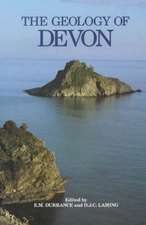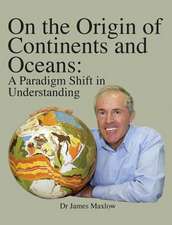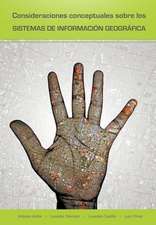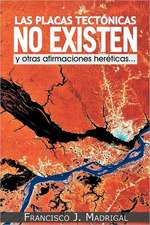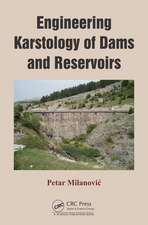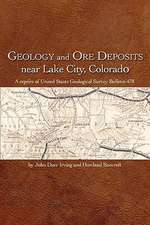Soil Clays: Linking Geology, Biology, Agriculture, and the Environment
Autor G. Jock Churchman, Bruce Veldeen Limba Engleză Hardback – 26 iun 2019
This book aims to help improve predictions of important properties of soils through a modern understanding of their highly reactive clay minerals as they are formed and occur in soils worldwide. It examines how clays occur in soils and the role of soil clays in disparate applications including plant nutrition, soil structure, and water-holding capacity, soil quality, soil shrinkage and swelling, carbon sequestration, pollution control and remediation, medicine, forensic investigation, and deciphering human and environmental histories.
Features:
- Provides information on the conditions that lead to the formation of clay minerals in soils
- Distinguishes soil clays and types of clay minerals
- Describes clay mineral structures and their origins
- Describes occurrences and associations of clays in soil
- Details roles of clays in applications of soils
- Heavily illustrated with photos, diagrams, and electron micrographs
- Includes user-friendly description of a new method of identification
Preț: 1222.50 lei
Preț vechi: 1490.86 lei
-18% Nou
Puncte Express: 1834
Preț estimativ în valută:
234.03€ • 240.82$ • 197.28£
234.03€ • 240.82$ • 197.28£
Carte tipărită la comandă
Livrare economică 01-15 martie
Preluare comenzi: 021 569.72.76
Specificații
ISBN-13: 9781498770057
ISBN-10: 1498770053
Pagini: 294
Ilustrații: 7 Tables, black and white; 27 Illustrations, color; 70 Illustrations, black and white
Dimensiuni: 178 x 254 x 20 mm
Greutate: 0.58 kg
Ediția:1
Editura: CRC Press
Colecția CRC Press
ISBN-10: 1498770053
Pagini: 294
Ilustrații: 7 Tables, black and white; 27 Illustrations, color; 70 Illustrations, black and white
Dimensiuni: 178 x 254 x 20 mm
Greutate: 0.58 kg
Ediția:1
Editura: CRC Press
Colecția CRC Press
Public țintă
Academic and Professional ReferenceNotă biografică
G. Jock Churchman is adjunct senior lecturer at the University of Adelaide (Australia) and adjunct
associate professor at the University of South Australia. Jock Churchman’s clay interests began with
a PhD in chemistry on halloysite at the University of Otago in his native New Zealand, followed
by industrial ceramic research (1970–1971). He held a postdoctoral fellowship in soil science at the
University of Wisconsin–Madison (1971–1973) and was employed at the New Zealand Soil Bureau
(1973–89), then at CSIRO (1989–2003), the University of Adelaide (2003–2012) and the University
of South Australia (2013–2014). He has also held visiting fellowships in soil science for one year at
Reading University (UK) and for six months at the University of Western Australia. His research
has encompassed halloysite; acid dissolution of montmorillonite; dust transport; clay mineral genesis;
clay–organic complexes; the influence of clay mineralogy on soil physical properties; clays in
sodic soils; the characteriation of bentonites and their industrial and environmental applications;
and the philosophy of soil science.
He has published nearly 150 refereed papers and coedited four books, most recently The Soil
Underfoot: Infinite Possibilities for a Finite Resource (CRC Press, 2014) and Natural Mineral
Nanotubes (CRC Press, 2015). He is a former editor (now emeritus) of Applied Clay Science. He
has received awards from the New Zealand Society of Soil Science, Soil Science Australia, the
Association Internationale pour l’Étude des Argiles (AIPEA) and the Clay Minerals Society.
Bruce Velde is an emeritus researcher for the Centre Nationale de Recherche Scientifique at the
Ecole Normale Supérieure in Paris. He did his PhD at Montana State University (1962) under the
direction of John Hower, then he did a postdoctoral study at the Carnegie Geophysical Laboratory
in Washington DC (1962–1965) after which he joined the CNRS in Paris.
The initial research subjects treated were the evolution of clay minerals in sediments and sedimentary
rocks, and their stability under different laboratory conditions of pressure and temperature.
During the latter period, he published 237 refereed papers, authored and coauthored 8 books on
clays and their chemical relations in natural situations and advised 22 PhD theses on these subjects.
His books are Clays and Clay Minerals in Natural and Synthetic Systems (Springer, 1977);
Introduction to Clay Minerals: Chemistry, Uses and Environmental Significance (Chapman & Hall,
1992); Archaeological Ceramic Materials: Origin and Utilization (Springer, 1999); Clay Minerals:
A Physico-Chemical Explanation of Their Occurrence (Elsevier, 2000); Illite: Origins, Evolution
and Metamorphism (Springer, 2004); The Origin of Clay Minerals in Soils and Weathered Rocks
(Springer, 2008); Soils, Plants and Clay Minerals: Mineral and Biologic Interactions (Springer,
2009); Origin and Mineralogy of Clays: Clays and the Environment (edited) (Springer, 2013); and
Geochemistry at the Earth’s Surface (2016).
The evolution of his work was to understand the chemical and physical reasons for the variety
and stability of clay mineral associations from depth towards the surface of the Earth. He also did
work on the formation of clay-associated structures (aggregates) and surface cracking using image
analysis.
associate professor at the University of South Australia. Jock Churchman’s clay interests began with
a PhD in chemistry on halloysite at the University of Otago in his native New Zealand, followed
by industrial ceramic research (1970–1971). He held a postdoctoral fellowship in soil science at the
University of Wisconsin–Madison (1971–1973) and was employed at the New Zealand Soil Bureau
(1973–89), then at CSIRO (1989–2003), the University of Adelaide (2003–2012) and the University
of South Australia (2013–2014). He has also held visiting fellowships in soil science for one year at
Reading University (UK) and for six months at the University of Western Australia. His research
has encompassed halloysite; acid dissolution of montmorillonite; dust transport; clay mineral genesis;
clay–organic complexes; the influence of clay mineralogy on soil physical properties; clays in
sodic soils; the characteriation of bentonites and their industrial and environmental applications;
and the philosophy of soil science.
He has published nearly 150 refereed papers and coedited four books, most recently The Soil
Underfoot: Infinite Possibilities for a Finite Resource (CRC Press, 2014) and Natural Mineral
Nanotubes (CRC Press, 2015). He is a former editor (now emeritus) of Applied Clay Science. He
has received awards from the New Zealand Society of Soil Science, Soil Science Australia, the
Association Internationale pour l’Étude des Argiles (AIPEA) and the Clay Minerals Society.
Bruce Velde is an emeritus researcher for the Centre Nationale de Recherche Scientifique at the
Ecole Normale Supérieure in Paris. He did his PhD at Montana State University (1962) under the
direction of John Hower, then he did a postdoctoral study at the Carnegie Geophysical Laboratory
in Washington DC (1962–1965) after which he joined the CNRS in Paris.
The initial research subjects treated were the evolution of clay minerals in sediments and sedimentary
rocks, and their stability under different laboratory conditions of pressure and temperature.
During the latter period, he published 237 refereed papers, authored and coauthored 8 books on
clays and their chemical relations in natural situations and advised 22 PhD theses on these subjects.
His books are Clays and Clay Minerals in Natural and Synthetic Systems (Springer, 1977);
Introduction to Clay Minerals: Chemistry, Uses and Environmental Significance (Chapman & Hall,
1992); Archaeological Ceramic Materials: Origin and Utilization (Springer, 1999); Clay Minerals:
A Physico-Chemical Explanation of Their Occurrence (Elsevier, 2000); Illite: Origins, Evolution
and Metamorphism (Springer, 2004); The Origin of Clay Minerals in Soils and Weathered Rocks
(Springer, 2008); Soils, Plants and Clay Minerals: Mineral and Biologic Interactions (Springer,
2009); Origin and Mineralogy of Clays: Clays and the Environment (edited) (Springer, 2013); and
Geochemistry at the Earth’s Surface (2016).
The evolution of his work was to understand the chemical and physical reasons for the variety
and stability of clay mineral associations from depth towards the surface of the Earth. He also did
work on the formation of clay-associated structures (aggregates) and surface cracking using image
analysis.
Cuprins
Authors Chapter 1 Introduction and Definitions Chapter 2 Soil Clays: Mineralogy Chapter 3 Geology: Defining the Starting Point for Soil and Clay Formation Chapter 4 Primary Minerals and Their Alteration by Weathering Chapter 5 Driving Forces of Alteration Chapter 6 Chemistry of Alteration by Weathering Chapter 7 Formation of Clays in the Soil Zone of Alteration 7.3 Effect of Plants on Soil Clay Assemblages Chapter 8 Nature and Origin of Surface Soil Clays Chapter 9 The Importance of Climate in the Formation of Soil Clays Chapter 10 Associations of Soil Clays Chapter 11 Occurrence and Extraction of Soil Clays Chapter 12 Identification and Quantification of Clay Minerals in Soils Chapter 13 Surfaces, Surface Reactions and Particle Size Effects Chapter 14 Role of Soil Clays in Agriculture, the Environment and Society Chapter 15 Summary Bibliography, Annex: Simplified Methods for the Interpretation of X-Ray Diffraction, Diagrams of Soil Clay Assemblages, Index
Descriere
This book aims to help improve predictions of important properties of soils through a modern understanding of their highly reactive clay minerals as they are formed and occur in soils worldwide. It examines how clays occur in soils and the role of soil clays in disparate applications.




